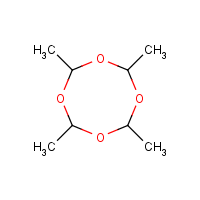Metaldehyde
Agent Name
Metaldehyde
CAS Number
108-62-3
Formula
C8-H16-O4
Major Category
Pesticides

Synonyms
2,4,6,8-Tetramethyl-1,3,5,7-tetroxocane; Acetaldehyde, tetramer; Ariotox; Cekumeta; Corry's Slug Death; Halizan; Metacetaldehyde; Metaldehyd [German]; Metaldeide [Italian]; Metason; Slug-Tox; r-2,c-4,c-6,c-8-Tetramethyl-1,3,5,7-tetroxocane; 1,3,5,7-Tetroxocane, 2,4,6,8-tetramethyl-; 2,4,6,8-Tetramethyl-1,3,5,7-tetraoxacyclooctane; [ChemIDplus] UN1332
Category
Molluscicides
Description
Solid; [IUCLID] Formulated as granules, pellets, mini-pellets, meal, paste, and liquid; [Reference #1] Colorless or white solid; [Reference #2] White odorless powder; [Alfa Aesar MSDS]
Sources/Uses
Used for control of snails in seed crops, turf, ornamentals, berries, citrus, vegetables, and other crops; [Reference #1] Used for synthesis in the chemical industry, as odor agent, and as pesticide; [IUCLID] Used as molluscicide, solid fuel for small heaters (alcohol replacement), and fire starter; [Reference #2]
Comments
Not irritating to skin and slightly irritating to eyes of rabbits; Neurological effects (ataxia, twitching, tremors, and hind-limb paralysis) observed in studies of dogs and rats; No increased susceptibility of fetuses seen in developmental toxicity and 2-generation reproduction studies of rats and rabbits; Atrophy of the testes and prostate observed in chronic oral study of dogs (LOAEL = 90 mg/kg/day); [Reference #1] Slowly hydrolyzed in acidic media (i.e., in the stomach) to acetaldehyde (the main toxicologically significant component) which is further oxidized to acetic acid; A skin, eye, and mucous membrane irritant; May be corrosive to eyes; Inhalation of fumes can cause CNS depression, convulsions, and coma; Interferes with reproductive process in rats; No evidence of teratogenicity, carcinogenicity, or mutagenicity; [Reference #2] Highly flammable; An irritant; Toxic by ingestion; [Alfa Aesar MSDS] See "Polyacetaldehyde."
Reference Link #1
Biomedical References
Exposure Assessment
Lethal Concentration
LC50 (rat) = 3,140 mg/m3/4hr
Reference Link #2
NFPA
may ignite at ambient temp
Adverse Effects
Neurotoxin
Other CNS neurotoxin
Hepatotoxin
Hepatoxic (a) from occupational exposure (secondary effect) or (b) in animal studies or in humans after ingestion
Diseases, Processes, and Activities Linked to This Agent
Processes
Industrial Processes with risk of exposure: